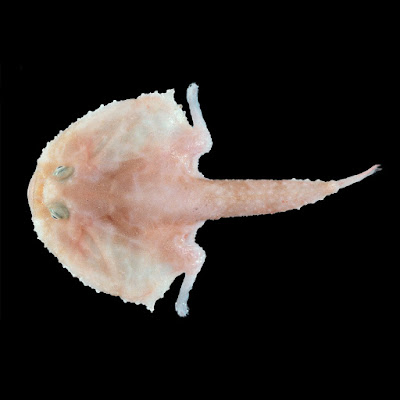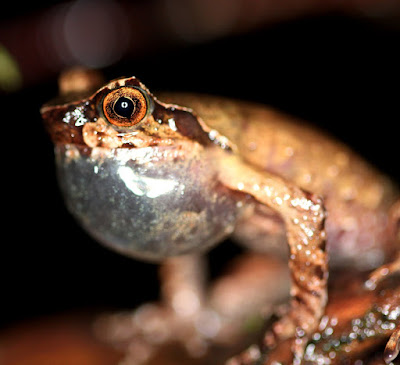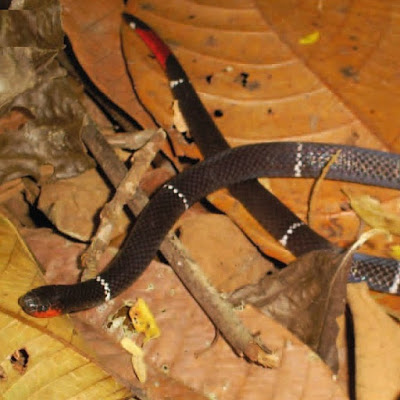[Most Recent Entries] [Calendar View]
Thursday, November 1st, 2018
| Time | Event | ||||||||
| 10:10a | [Ichthyology • 2018] Review of the Batfish Genus Halicmetus Alcock, 1891 (Lophiiformes: Ogcocephalidae) from Australian Waters, with Descriptions of Two New Species; Halicmetus westraliensis & H. drypus
Abstract A taxonomic review of species of the Indo–Pacific batfish genus Halicmetus occurring in the Australian Exclusive Economic Zone is provided. Treatments of six species in the region, including diagnoses of the widespread Halicmetus niger Ho, Endo & Sakamaki, 2008, H. reticulatus Smith & Radcliffe, 1912 and H. ruber Alcock 1891, a reclassification of the poorly known H. marmoratus Weber, 1913, and descriptions of two new species, Halicmetus westraliensis n. sp. (an Australian endemic) and H. drypus n. sp. (from the northern sector of the Australian Exclusive Economic Zone off Norfolk Island). The Australian species can be distinguished from each other and regional congeners by a combination of morphometrics, meristics and colouration. A key is provided for all known species of the genus. Keywords: Pisces, taxonomy, review, Halicmetus, new species, Australia Halicmetus Alcock Halicmetus Alcock, 1891:27. Type species: Halicmetus ruber Alcock, 1891, by monotypy. .... Valid species. Halicmetus is represented in the Indo–Pacific by six valid nominal taxa: H. drypus n. sp., H. marmoratus Weber, 1913, H. niger Ho, Endo & Sakamaki, 2008, H. reticulatus Smith & Radcliffe, 1912, H. ruber Alcock, 1891, and H. westraliensis n. sp., and one undescribed species, H. cf. ruber (sensu Ho et al., 2008).
Halicmetus westraliensis sp. nov. Vernacular name: West Australian Shortnose Seabat. Etymology. The name westraliensis is a reference to the type locality, Western Australia. Halicmetus drypus sp. nov. Vernacular name: Pink Shortnose Seabat Etymology. From the Greek drypus, referring to the pink plant genus Drypis of the Tribe Drypideae, family Caryophyllaceae. Halicmetus marmoratus Weber, 1913 Vernacular name: Marbled Shortnose Seabat Halicmetus ruber Alcock, 1891 Vernacular name: Red Shortnose Seabat Halicmetus reticulatus Smith & Radcliffe, 1912 Vernacular name: Reticulated Shortnose Seabat Halicmetus niger Ho, Endo & Sakamaki, 2008 Vernacular name: Black Shortnose Seabat Hsuan-Ching Ho and Peter R. Last. 2018. Review of the Batfish Genus Halicmetus Alcock, 1891 from Australian Waters, with Descriptions of Two New Species (Lophiiformes: Ogcocephalidae). Zootaxa. 4508(2); 179–196. DOI: 10.11646/zootaxa.4508.2.2 | ||||||||
| 10:35a | [Ichthyology • 2018] Histiophryne narungga • Fantastic Beasts and Where to Find Them: A New Species of the Frogfish Genus Histiophryne Gill (Lophiiformes: Antennariidae: Histiophryninae) from Western and South Australia, with A Revised Key to Congeners
An undescribed species of the frogfish genus Histiophryne, of the teleost order Lophiiformes, family Antennariidae, is described on the basis of 60 specimens collected from shallow inshore waters of Western and South Australia. Previously confused with its morphologically similar congener H. cryptacanthus, it differs from the latter and from all other members of the genus in having the following combination of features: illicium tiny but easily discernible without aid of a microscope; esca present, a small tuft of filaments, easily distinguished from illicium; skin covered with tiny dermal spinules, especially on head, cutaneous filaments and appendages absent; dorsal-fin rays 15–16; pectoral-fin rays 9 (rarely 8); vertebrae 22–23; head, body, and fins typically off white, sometimes peppered with numerous small, close-set ocelli. Genetic divergence from its congeners in the nuclear recombination activation gene-2 (RAG2) and cytochrome oxidase-I (COI) genes is at least 8.9%. The new species is diagnosed, described, and compared with its congeners. A revised key to the species of the genus is also provided.
Histiophryne narungga, new species New Nharangga name: Nharangga Warrga Guuya New English name: Narungga Frogfish Etymology.— The specific epithet narungga honors a tribe of Indigenous Australians, the Narungga (otherwise known as the Narangga), whose traditional lands are located throughout Yorke Peninsula, from near Port Wakefield in the east to Port Broughton in the west, and all the way down to the southern tip of the Peninsula (Sutton, 1899; Tindale, 1936). Rachel J. Arnold and Theodore W. Pietsch. 2018. Fantastic Beasts and Where to Find Them: A New Species of the Frogfish Genus Histiophryne Gill (Lophiiformes: Antennariidae: Histiophryninae) from Western and South Australia, with A Revised Key to Congeners. Copeia. 106(4); 622-631. DOI: 10.1643/CI-18-112 twitter.com/ASIHCopeia/status/1057667167439802369 | ||||||||
| 10:40a | [Herpetology • 2018] Two New and Potentially Highly Threatened Megophrys Horned Frogs (Amphibia: Megophryidae) from Indochina’s Highest Mountains; Megophrys (Panophrys) fansipanensis & M. (P.) hoanglienensis
Abstract Megophrys are a group of morphologically conserved, primarily forest-dependent frogs known to harbour cryptic species diversity. In this study, we examined populations of small-sized Megophrys from mid- and high elevation locations in the Hoang Lien Range, northern Vietnam. On the basis of morphological, molecular and bioacoustic data, individuals of these populations differed from all species of Megophrys known from mainland Southeast Asia north of the Isthmus of Kra and from neighbouring provinces in China. Further, the newly collected specimens formed two distinct species-level groups. We herein describe two new species, Megophrys fansipanensis sp. nov. and Megophrys hoanglienensis sp. nov. Both new species are range restricted and likely to be highly threatened by habitat degradation. These discoveries highlight the importance of the Hoang Lien Range for Vietnam’s amphibian diversity. Keywords: Amphibia, Bioacoustics, Hoang Lien, Megophryinae, Megophrys fansipanensis sp. nov., Megophrys hoanglienensis sp. nov., Panophrys, Southeast Asia, sympatric, Xenophrys
Megophrys (Panophrys) fansipanensis sp. nov. Etymology: Specific epithet “fansipanensis” is a toponym in reference to the type locality of the species, meaning “from [Mount] Fansipan”. Suggested vernacular name: Mount Fansipan horned frog (English), Ếch sừng phan xi păng (Vietnamese).
Megophrys (Panophrys) hoanglienensis sp. nov. Etymology: Specific epithet “hoanglienensis” is a toponym in reference to the type locality of the species, meaning “from Hoang Lien” Range. Suggested vernacular name: Hoang Lien horned frog (English), Ếch sừng hoàng liên (Vietnamese).
Benjamin Tapley, Timothy Cutajar, Stephen Mahony, Chung T. Nguyen, Vinh Q. Dau, Anh M. Luong, Dzung T. Le, Tao T. Nguyen, Truong Q. Nguyen, Christopher Portway, Hào V. Lương and Jodi J. L. Rowley. 2018. Two New and Potentially Highly threatened Megophrys Horned Frogs (Amphibia: Megophryidae) from Indochina’s Highest Mountains. Zootaxa. 4508(3); 301–333. DOI: 10.11646/zootaxa.4508.3.1 | ||||||||
| 11:24a | [Herpetology • 2018] Micrurus boicora • A Remarkable New Species of Coralsnake of the Micrurus hemprichii species group from the Brazilian Amazon
Abstract A new species of elapid snake of the genus Micrurus is described herein, from the states of Rondônia and Mato Grosso, in the western Brazilian Amazon. The new species has a single anal plate, a unique characteristic shared with members of the M. hemprichii species group. It can be distinguished from the other members of this group by having a parietal reddish band in juveniles (absent in adults) and the absence of brownish or orange-yellow dorsal body bands. In addition, this species is distinguished from M. hemprichii by its lower number of body triads, and from M. ortoni by its lower numbers of ventrals and subcaudals scales. Key words: Squamata, Serpentes, Elapidae, Amazon rainforest, colour pattern, external morphology, Neotropical region.
Micrurus boicora sp. n. Micrurus hemprichii nec (Jan, 1858) – Bernarde & Abe, 2006 Micrurus hemprichii nec (Jan, 1858) – Turci & Bernarde, 2008 Micrurus sp. nov. – Bernarde et al. 2012 Diagnosis and comparisons: Micrurus boicora can be distinguished from all congeners by the following combination of characters: cloacal plate single; narrow parietal reddish band in juveniles present (absent in adults); body triads 5; brownish or orange-yellow dorsal body bands absent; white body rings equidistantly arranged, more than 11 ventral scales apart; red gular region; with red spots on belly triads; ventrals 155–166; subcaudals 19–23. .... Etymology: The specific epithet boicora is a Tupi-Guarani name (mbóî = snake; corá = coral), employed herein as a noun in apposition alluding to the coral coloration of the new species. Many Amerindians and peasants in Brazil collectively name true coralsnakes and their mimics as “Boicorá”. Paulo Sérgio Bernarde, Luiz Carlos Batista Turci, Arthur Diesel Abegg and Francisco Luís Franco. 2018. A Remarkable New Species of Coralsnake of the Micrurus hemprichii species group from the Brazilian Amazon. SALAMANDRA. 54(4); 249-258. Resumo: Uma nova espécie de serpente elapídea do gênero Micrurus é descrita aqui, proveniente dos estados de Rondônia e Mato Grosso, no oeste da Amazônia Brasileira. A nova espécie possui placa anal simples, uma característica unicamente compartilhada entre os membros do grupo de espécies M. hemprichii. Ela é diagnosticável dos outros membros desse grupo por possuir banda parietal avermelhada em juvenis (ausente em adultos) e ausência de bandas dorsais corporais amareladas ou laranjas. Além disso, essa espécie distingue-se de M. hemprichii pelo menor número de tríades corporais, e de M. ortoni pelo menor número de escamas ventrais e subcaudais. Palavras-chave. Squamata, Serpentes, Elapidae, Floresta Amazônica, padrão de coloração, morfologia externa, Região Neotropical. |
| << Previous Day |
2018/11/01 [Calendar] |
Next Day >> |





















